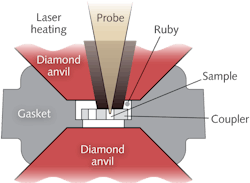Laser heating shows that petroleum could have non-dinosaur origins
Scientific evidence supports the origination of petroleum reserves from the decay of carbon matter such as ancient dinosaur and vegetation remains. However, researchers at the Carnegie Institution of Washington (Washington, DC), the Lomonosov Moscow State Academy of Fine Chemical Technology (Moscow, Russia), and the Royal Institute of Technology (Stockholm, Sweden) have used laser heating in a diamond anvil cell (DAC) to demonstrate that high-temperature compression of natural elements in the upper mantle of the earth do indeed create hydrocarbons that could be transported through deep faults to shallower regions of the crust and contribute to petroleum reserves in an abiotic (having nothing to do with biology) process.
By exposing methane and ethane—both naturally occurring mantle gases—to pressures higher than 2 GPa and heating them with a yttrium lithium fluoride (YLF) laser inside a DAC to mantle-like temperatures between 1000 and 1500 K, the researchers discovered that the methane partially reacts to form saturated hydrocarbons (ethane, propane, and butane), molecular hydrogen, and graphite. These hydrocarbons are a primary component of petroleum and were detected in the experiments using Raman spectroscopy. A 100 mW, 458 nm argon-ion laser source excited the sample and the Raman spectra were collected with a 460 mm focal-length imaging spectrograph. Contact Alexander Goncharov at [email protected].
